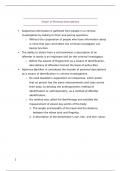Origin of Personal Descriptions
Subjective information is gathered from people in a criminal
investigation by talking to them and posing questions.
o Without the cooperation of people who have information about
a crime that was committed, the criminal investigator can
barely function.
The ability to obtain from a victim/witness a description of an
offender in words is an important skill for the criminal investigator.
o Before the advent of fingerprints as a means of identification,
descriptions of offenders formed the basis of police files.
Alphonse Bertillon is considered the founder of personal descriptions
as a means of identification in criminal investigations.
o He used Quetelet’s supposition of uniqueness, which posits
that no person has the same measurements and sizes across
their body, to develop the anthropometric method of
identification or anthropometry, as a method of offender
identification.
o His method was called the Bertillonage and entailed the
measurement of eleven key points of the body:
1. The length and breadth of the head and the distance
between the elbow joint and fingertip.
2. A description of the perpetrator’s eye, hair, and skin colour.
1
, What do personal Descriptions (PDs) Entail?
It is important to distinguish between different types of witnesses
(direct sources/subjective information) in criminal investigations.
o An eyewitness: A person who personally saw the crime
transpire.
Eg. A customer at a 24-hour Sasol tuckshop, sees a
robber walk up to the counter, raise a gun, and shoot the
cashier during a robbery.
o A corroborative witness: A person who can provide
information about the circumstances which surround a crime.
Eg. A person was walking towards the tuckshop when he
heard what sounded like a gunshot and saw a person
running out of the tuckshop with a gun in hand, and then
found the cashier was shot upon entering the Sasol
tuckshop.
Both types of witnesses can provide valuable information and may
be able to identify the suspect.
o The evidence of the eyewitness would be given more weight
during the trial.
This is because the witness was present and saw the
suspect shoot the victim.
o The corroborative witness can provide strong evidence to
suggest that the man running from the store committed the
crime, however, additional information would be needed to
support the assumption that the person seen running from the
tuckshop committed the crime.
In the case of an eyewitness, the additional evidence is a value that
is added, while in the case of the corroborative witness, more
2
, evidence is required to support the conclusion of guilt beyond a
reasonable doubt.
o The court will give additional weight to evidence that comes
from persons who are unbiased independent witnesses, also
known as third-party witnesses, who are characterised as
such because they are in no way associated with the victim,
suspect, or the crime.
An independent witness can be an independent
eyewitness or independent corroborative witness of a
crime and has nothing to lose or gain from the outcome
of the case.
1. A physical description is a verbal description of the physical features
of an alleged perpetrator.
o When the criminal investigator takes down a physical
description, the items that are included in the physical
description are:
Surrounding features (e.g. race, age, and sex).
The head (e.g. size and shape, nose, mouth, chin, hair,
eyes, cheeks, teeth, and ears).
The rest of the body (e.g. neck, shoulders, arms, hands,
chest, stomach, hips, legs, and feet).
Physical peculiarities (e.g. abnormalities, gait, voice,
speech traits and language).
o It is a difficult task to describe someone in words, mostly
because the public does not know the descriptive words
needed to describe physical features (e.g. the shape of eyes,
the nose, lips etc.).
2. The difficulty in expressing in words what someone looks like is
ameliorated by the police through using supplementary techniques
to assist the witness in ensuring that descriptions are as accurate as
3




